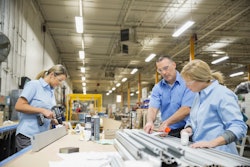
Purchase orders tripled overnight. Lines ran around the clock to ensure demand was met. Retailers’ shelves remained stocked. E-commerce orders reached their destinations. Contract manufacturer’s work accelerated as a direct response to frenzied consumer buying patterns trigged by the pandemic’s shock wave across global supply chains.
Factory floors teaming with workers as a critical business component is no longer the best option for manufacturers. Why is this? Manufacturers are looking to reduce capital expenditures with a greater focus around value, not cost. Delegating manufacturing to an outside source allows companies to hedge their bets on innovative new products by shifting their spend on marketing rather than hard assets.
Managing the packaging operations for consumer packaged goods (CPGs) has given contract packagers a front row seat to the steady build toward external manufacturing for years. The Contract Packaging Association’s 2018 State of the Industry Report forecasts the industry to surpass $75 billion by close of 2020, up from $53.6 billion in 2017.
What do you really gain with an external manufacturer?
Is there a downside to a contract manufacturer? Of course there is. You always lose some control when you go outside your organization. That’s why trust is the single most important criteria for choosing an external manufacturer. These are the people who will get the job done – for you, your customers, your leadership, your board of directors. They are an extension of your brand and an ambassador of your values. Here are five reasons more manufacturers are using external manufacturers.
1. Faster speed to market. Timing is everything, and when it comes to supply chains, an improved time to market influences revenue generation. Getting your product to market promptly means the odds are good that your competitor won’t grab market share first. An experienced contract manufacturer can help you stick to schedules based on lead times; provide resource management; satisfy project phase requirements; and maintain a safe, reliable, code compliant and on-time delivery to market.
2. Reduced overhead. Outsourcing reduces overhead, including less capital investment in buying new assets and technology, as well as hiring the staff needed to manage the lines. This means peak efficiency as the CPG can focus on marketing efforts, new product innovation and core products.
3. Strategic operational decision. External manufacturing is a strategic operational decision, not a tactical process. Many contract manufacturers have the ability to oversee product launches from concept to completion, including formulation, custom testing, regulatory and market guidance consulting, manufacturing, packaging, delivery timelines and distribution. The value of external manufacturing drives your business strategy.
4. Meet green goals. Many external manufacturers are at the forefront of packaging materials research and know how to test different film structures' viability, be it compostable, recyclable or reusable. They can reduce risk, lower cost and draw from their value chain of vendors to inspire the most advanced and tested options, all while doing it competitively.
5. Handle increased demand. External manufacturers have the agility to pick up additional lines and become the CPGs’ external manufacturing arm to enhance production efficiency and product customization. External manufacturing gives organizations an opportunity to scale faster.
Manufacturing, ever defined as an industry of makers, is evolving. An article by McKinsey & Company points out that “...externally sourced innovations are typically commercialized 40% faster than home-grown ideas, often because they have already been partly validated by the supplier.” The rise of external manufacturing is also the rise of manufacturing itself in a new world of heightened collaboration.









